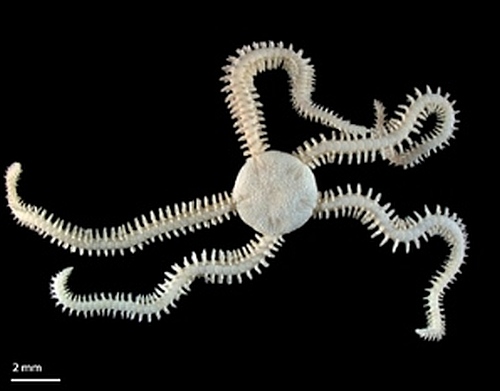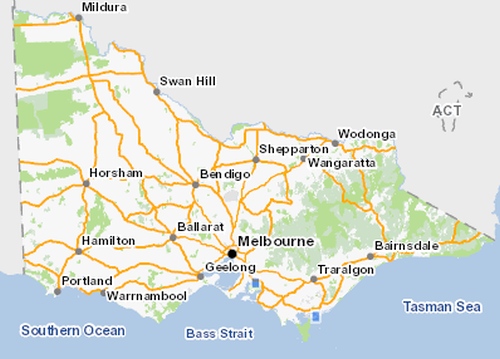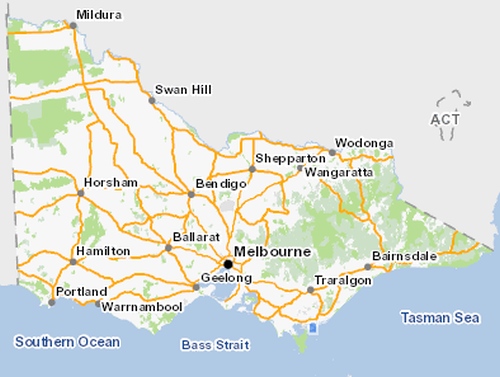Brittle Star (Amphiura triscacantha) and (Ophiocomina australis)

Brittle Star, Family: Amphiuridae, with distinct central disc and five radiating slender, highly flexible arms. Source: Museum Victoria
Brittle Stars are part of the benthic (bottom feeding) fauna found in the marine environment. They are broadly referred to as Echinoderms, classified in the Phylum Echinodermata which are marine animals having radial symmetry with five parts, often with spines. They have a unique water vascular system and depending on the species have an internal or external calcite skeleton.
The Phylum Echinodermata is divided into five classes;
- Crinoidea (feather-stars),
- Asteroidea (sea-stars),
- Echinoidea (sea-urchins),
- Holothuriodea (sea-slugs)
- Ophiuroidea (brittle-stars).
The name Ophiuroidea is derived from the Greek words ophis, meaning snake, and oura, meaning tail, in reference to the often thin, snail-like winding or coiling arms of the brittle stars.
Worldwide the class Ophiuroidea are currently divided into two orders and 16 families; the largest are Amphiuridae (467 species), Ophiacanthidae (319 species) and Ophiuridae (344 species), and the majority of the species (1883) belong to the order Ophiurida (Stöhr et al. 2012).
Threatened Brittle Stars in Victoria
There are at least 40 species of brittle stars in Victorian waters. None are endemic to Victoria but two species, Amphiura triscacantha and Clarkcoma australis (previously referred to as Ophiocomina australis) are considered Threatened and Listed under the Victorian Flora and Fauna Guarantee Act 1988. Both species have extremely limited distribution and found in association with seagrass habitat which is sensitive to environmental degradation (O’Hara & Barmby 2000)
The Brittle Stars Amphiura triscacantha and Clarkcoma australis have central disks about 1 cm in diameter. Brittle Star taxonomy is quite detailed with a number of features used to identify the various species e.g. disk and arm structure and cover, mouth and jaw structure.
| Brittle Star Amphiura triscacantha | ||||||||||
| ||||||||||
| Status | ||||||||||
|

The Brittle Star Amphiura triscacantha of Brittle Star is only known from a small number of areas in southern Australian waters, Spencer and St Vincent Gulfs in South Australia and two locations in Victoria; Nooramunga (Gippsland) and possibly Western Port Bay (French Island Marine National Park) although it is thought the Western Port Bay population is extinct due to decline of seagrass beds.
It is reported that many previous records of this species are mis-identifications as young animals can be easily confused with other species (O’Hara & Barmby 2000)
The conservation status of Amphiura triscacantha was re-assessed from Vulnerable in 2009 (DSE 2009) to Endangered in 2020 as part of the Conservation Status Assessment Project – Victoria (DELWP 2020). This species is now listed as Endangered in Victoria under the Flora and Fauna Guarantee Act 1988 - Threatened List - June 2021 (DELWP 2021).
| Brittle Star Clarkcoma australis | ||||||||||
| ||||||||||
| Status | ||||||||||
|

Clarkcoma australis (previously referred to as Ophiocomina australis) is only known from a small number of areas in southern Australian waters, Spencer and St Vincent Gulfs in South Australia and one location in Victoria in the Nooramunga area (South Gippsland) (O’Hara & Barmby 2000) .
The conservation status of Clarkcoma australis was re-assessed from Vulnerable in 2009 to Critically Endangered in 2020 as part of the Conservation Status Assessment Project – Victoria (DELWP 2020). This species is now listed as Critically Endangered in Victoria under the Flora and Fauna Guarantee Act 1988 - Threatened List - September 2022 (DELWP 2022).
Ecology
Brittle Stars are secretive animals which hide under rocks or in crevices, bottom substrates or conceal themselves amongst seagrass and other marine organisms. They tend to be more active at night, possibly reducing their chances of being eaten.
Key habitat
The species Clarkcoma australis and Amphiura triscacantha are both found in association with Posidonia and Heterozostera (eel grass) seagrass beds. Clarkcoma australis also on Pinna bivalves (O’Hara & Barmby 2000)
Neither species is considered inter-tidal having a depth range of 1-12 m (AFD 2017).
Movement
Brittle Stars move around by using their arms rather than movement of tube feet as in sea stars as they lack suction cups,
Feeding
Brittle Stars show a broad range of feeding types, such as suspension-feeding, deposit-feeding, scavenging and predation, all designed for a more selective nutrient intake. They have been found to ingest fine particles as well as a wide range of animal and plant fragments indicating an omnivorous habit (Stöhr et al. 2012)
Threats
Posidonia australis is endemic to southern Australia and northeast Tasmania. The overall population has experienced serious declines (IUCN Red List Status: Near threatened).
Nutrients - nutrients increase the growth of undesirable algae which can smother seagrass beds, depriving them of light resulting in severely degraded health or total loss.
Sediment - increased turbidity as a result of sedimentation is of particular concern in Western Port Bay (Edmunds et al. 2009). It is also thought the extensive loss of seagrass in the 1970s and 1980s is attributed increased turbidity.
The intertidal and shallow sub-tidal zones of Western Port Bay once supported a large area (250 km2 ) of seagrass beds and macrophytes in 1973 which had declined by 70 % in area by 1983. In 2001 the seagrass beds had partially recovered in some areas to 130 km2 . (Edmunds et al. 2009)
Toxicants - chemical toxicants can accumulate on bottom substrates and be consumed by detritus feeders such as Brittle Stars.
Oil pollution - heavy oil sinks to the sea floor which can smother seagrass beds and micro habitats. It can also be ingested by marine organisms in minute quantities which can accumulate over time in the ecosystem.
Salinity - flood water has the capacity to alter salinity in shallow embayment's.
Acidity - Changes in water pH can occur from oxidation in acid sulfate soils This can lead to a significant decrease in pH within water runoff.
Physical disturbance - direct loss of seagrass habitat from dredging and dragging of anchors.
Key land/waterway managers
- Wellington Shire
- Parks Victoria (Nooramunga Marine & Coastal Park)
- West Gippsland Catchment Management Authority
Selected references
AFD (2017) Australian Faunal Directory, Family AMPHIURIDAE, Australian Government, Department of the Environment & Energy.
DELWP (2022) Flora and Fauna Guarantee Act 1988 - Threatened List - September 2022, Department of Environment Land Water and Planning, Victoria.
DELWP (2020) Provisional re-assessments of taxa as part of the Conservation Status Assessment Project – Victoria 2020, Department of Environment Land Water and Planning, Victoria. Conservation Status Assessment Project – Victoria
DSE ( 2009) Advisory List of Threatened Invertebrate Fauna In Victoria - 2009, Department of Environment, Land, Water & Planning, Victoria. [Accessed January 2017]
Edmunds M, Mustoe S, Stewart K, Sheedy E and Ong J (2009) VNPA Nature Conservation Review: Marine Conservation Priorities and Issues for Victoria: Appendices. Report to Victorian National Parks Association. Australian Marine Ecology Report 405 pdf, Melbourne.
O’Hara, T. and Barmby, V. (2000). Victorian Marine Species of Conservation Concern: Molluscs, Echinoderms and Decapod Crustaceans. pdf Parks, Flora and Fauna Division, Department of Natural Resources and Environment, East Melbourne, Australia.
Stöhr S, O'Hara TD, Thuy B (2012) Global Diversity of Brittle Stars (Echinodermata: Ophiuroidea). doi:10.1371/journal.pone.0031940
Please contribute information regarding Brittle Stars in the Nooramunga Marine & Coastal Park - observations, images or projects. Contact SWIFFT


